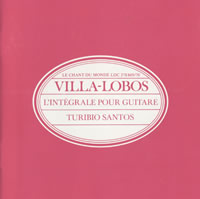 Clique aqui para baixar a primeira parte/Download the first part - Badongo
Clique aqui para baixar a primeira parte/Download the first part - Badongoou / or
Clique aqui para baixar a primeira parte/Download the first part - RapidShareClique aqui para baixar a segunda parte/Download the second part
- RapidShareVeja um trecho da entrevista de Turíbio Santos na TV Senado - programa "Quem tem medo da música clássica?", apresentado por Artur da Távola / Watch Turíbio Santos' interview by Artur da Távola - Real Media
Veja o trecho de um show de Turíbio Santos na TV Senado - programa "Espaço Cultural" / Watch Turíbio Santos playing - Real Media
........................................................
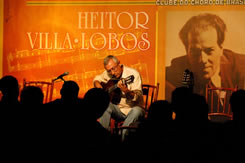
Em 7 de março último, o violonista Turíbio Santos completou 60 anos de idade. Seu trabalho é conhecido internacionalmente desde 1965, quando então venceu o famoso Concurso da ORTF, na França. Vários autores dedicaram-lhe peças, tais como Radamés Gnattali, Edino Krieger, Almeida Prado, Ricardo Tacuchián, Francisco Mignone e Leo Brouwer.
Nascido em São Luís, Maranhão, sua família se mudou para o Rio de Janeiro quando Turíbio estava com 3 anos de idade. Foi seu pai quem o influenciou a tocar violão, pois ele era um grande aficionado do violão, e um episódio histórico retrata bem isso: Agustín Barrios esteve em São Luís, antes de Turíbio nascer, e seu pai foi a uma praça pública reunir um público para que assistisse Barrios, porque não tinha ninguém no teatro.
No Rio, suas irmãs aprendiam violão em casa com um professor, sr. Molina, e Turíbio passou a ter aulas também. Depois foram orientados por Francisco Amaral.
Aos 12 anos, viu Andrés Segovia em um filme na embaixada americana. A experiência o marcou para sempre e descobriu que aquele era o ideal violonístico a ser atingido e por muito tempo assim prevaleceu.
Em 1957, então com 14 anos de idade, Turíbio conheceu Heitor Villa-Lobos na Escola de Canto Orfeônico no Rio em uma conferência sobre sua obra para violão. Anotou cada palavra de Villa-Lobos, a pedido de Hermínio Bello de Carvalho, que tinha um programa de rádio Violão de ontem e de hoje. Nessa época, Hermínio e Turíbio eram alunos de Antônio Rebello.
Em 1962, estava de férias em São Luís e acabou sendo convidado a dar um recital, que foi sua estréia como profissional. O recital foi pela SCAM - Sociedade de Cultura Artística Maranhense no belo Teatro Artur Azevedo. No mesmo ano tocou no Festival Villa-Lobos e a convite de Arminda Villa-Lobos gravou os 12 Estudos. Paralelamente, Turíbio estava prestando vestibular de Arquitetura no Rio de Janeiro.
Turíbio tem mais 50 registros em discos e CD's, mas o primeiro foi aos 18 anos para o Museu Villa-Lobos e que foi também o primeiro disco do Museu, no qual, como se sabe, foram gravados os 12 estudos de Villa-Lobos. Esta gravação lançaria seu nome no Brasil e na Europa anos mais tarde. Em seguida, em 1963 gravou em duo com o violonista uruguaio Oscar Cáceres.
Em março de 1964 ocorreu o Golpe Militar no Brasil, quando Turíbio estava cursando o 3.º ano de Arquitetura, e por causa da situação angustiante do país resolveu abandonar o curso universitário e decidiu ser violonista, pois raciocinou que assim teria mais controle sobre sua própria vida.
Em junho de 1965 ele vence o Concurso Internacional da Rádio e Televisão Francesa. Foi um feito histórico para a música no Brasil e o Concurso da ORTF abriu uma série de portas para ele na França, inclusive regravou os 12 Estudos lá.
Logo após o Concurso, ele é convidado a lecionar no maior conservatório municipal de Paris, que tinha 1500 alunos. Decidiu que iria ficar um ano, mas acabou ficando 10 anos, com viagens ao Brasil para compromissos profissionais e familiares. Paris era um ponto cultural de peso para a carreira, e lá ele permaneceu, se casou e teve dois filhos.
Em 1974 ele regressa ao Brasil pois queria que os filhos não perdessem o vinculo com o Brasil, Ainda se dirigiu à França intensamente até 1985, ano em que foi convidado a dirigir o Museu Villa-Lobos, cargo que exerce até hoje, além de uma intensa atividade como concertista.
Em 2002 Turíbio Santos lançou um livro autobiográfico Mentiras ... ou não? Uma quase autobiografia pela editora Jorge Zahar, em comemoração aos seus 40 anos de atividade profissional. Coordena a série Violão Amigo, de partituras de obras brasileiras, também pela Zahar, já com três volumes publicados.
************************

On a bleak winters night in January 2003 I sat in my bedroom in the hotel Manhattan with the Brazillian guitarist Victor Biglione and my friend the classical guitarist Ben Verdery. In the middle of a happy situation where we worked our way through a bottle of Dom Perignon and a couple of songs that we would play the subsequent night at Joe's Pub, Ben started to play some of the Villa-Lobos studies. Half way through study number eight Ben looked up and said "of course you know about the edits" and then proceeded to tell me about the original Villa-Lobos manuscripts and that it now appears that Segovia had edited some of the original writing. I poured another glass of Dom, while Ben played a beautiful chordal sequence from the 1928 version of study number ten, but missing in the 1929.
This was news. Like many guitarists I have lived with this music through most of my playing life. Lived with these seminal works by Villa-Lobos that sit in your head like a monolithic presence. Like a place you know and love, it is music that you invariably return to once again to take in its exotic aroma.
Having known this music only in the Segovia/Esching version I felt a mixture of intrigue and dismay at this information and determined to get a copy of the original manuscript and look at it for myself. A few weeks later with a copy of the original manuscript and articles by both Stanley Yates and Eduardo Fernandez, I found out the following. The earliest manuscript of the studies is dated as 1928. This version-with no dedivation to Segovia is replete with fingerings and expression markings written in meticulous detail even down to different size note heads to differentiate between thematic and structural lines.
Without going into elaborate detail here it may be sufficient to say that in the original Etude 10 there are 19 measures of new material and in Etude 11 a new passage of thirteen measure. The Segovia/Eschig edition, dated 1929, is without these passages. It is hard not to indulge in conjecture about Segovia's interraction with this marvellous and original guitar music where it seems - unless with the approval of Villa-Lobos, passages were cut out, fingerings re-written etc etc. And yet when they were finally published in 1953, Segovia in his preface to the studies remarks how he had no need to alter the fingerings of Villa-Lobos who knew the guitar so well.
In February of this year after spending a wild week at the Carnaval in Rio and experiencing Brazil in all of its finest throbbing intensity I paid a visit to the Villa-Lobos museum, to meet and talk with it's genial curator, the guitarist, Turibio Santos.
The museum is a charming old house that lies in the back streets of Botafogo. After meeting with Turibio in the sun dappled courtyard that contains a bust of Villa-Lobos we wandered in to the darkened rooms. On display are a cello, piano, various items that belonged Villa-Lobos, several oil paintings and video, film and sound archives. Along with this is a vast collection of original manuscripts that are stored in a room upstairs under controlled conditions. But of course what caught my eye was the guitar behind glass in the corner of the room, apparently the instrument on which Heitor composed all of his guitar music. I began the conversation by asking Turibo who the maker was and how Villa-Lobos came by it.
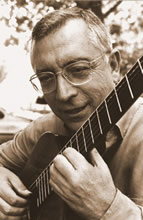
TS - It was given to Villa-Lobos in 1923, in Paris, by Tomas Teran. He was a pianist that afterwards came to Brazil and stayed here for the rest of his life.
AS - He gave him this guitar?TS - Yes. And he composed the twelve studies on this guitar.
AS - He wrote them on that actual guitar? Who is the maker?TS - Josef Bellido. A french guitar maker. It's a bit fat, but...
AS - Yes almost like a Martin Dreadnought. Unusual for a classical guitar. But he wrote the twelve studies on this instrument. Did he write the preludes on another guitar? TS - Probably this one, he had this guitar all his life.
AS - Yes, "this" was his guitar (laughs).TS - Yes, it is a nice guitar. A small sound but very good quality.
As - You have played it of course.TS - Yes, I have played it.
AS - That must have been a religous moment when you played his guitar!TS - (laughs) No, I am not impressed like that.
AS - Well, fantastic.TS - Would you like to see the library? We have all the originals.
We move upstairs to the library which is actually a teperature and humidy controlled room where they keep the original manuscrits. Naturally I was hoping they would pull out all of the guitar music for me so I could actually touch it. No such luck, but a young woman wearing white gloves did actually and rather gingerly remove the original Bachianas Brasileras Nº5 from its dark case to lay it like a butterfly on the table. We stared at it admiringly and I turned to Turibio and said "I want to ask you about the studies and the story about the edits" to which Turibio replied...
TS - This is where people look for music. Here you can search for anything. They never touch the originals. But for instance, if they ask they can see the original of Prelude Nº1. You can find everything here.
We looked at a few more pieces of music together and then moved upstairs to Turibio's office...
AS - I understand that in a few days it will be the birthday of Villa-Lobos. Do you commemorate that in any way?TS - The fifth of March is the day on which Villla-Lobos was born and now is classified by Brazilians as the day of classical music in Brazil. This weekend, on Sunday the fifth of March, we will have a concert here in the museum that will last for four or five hours.
AS - And the music will all be the music of Villa-Lobos. He is recognised as the founding father of modern classical music in Brazil. How long have you been the curator of the museum?TS - Twenty years. I started running the museum in 1986.
AS - Did the museum exist before that?TS - Yes. My relationship with the museum comes from the beginning of the museum. In fact I met Villa-Lobos himself personally in 1928.
AS - 1928? You must be what? About 110 years old.TS - Sorry (laughs). 1958! When he was doing some lectures about his own music. The main lecture that I attended was about his guitar music and this was absolutely fabulous, because a friend of mine, who was a musicologist, was supposed to come to make notes. But then, he became ill, so he asked me to note every word that Villa-Lobos was saying.
AS - That's fantastic. Is there a print out of those notes?TS - Yes, there is a book - a Turibio Santos' book - with the lecture inside. He talked about the compositions. The preludes, for example. They were written as an hommage. For example, the first one is an hommage to the the men of the interior of Brazil. The second one was to the capadochio Carioca – malandro. The third one was an hommage to the music of Bach. The fourth to the Indians of Brazil and the fifth is an hommage to the social life of Rio. The kids all dressed up in fancy clothes as they go to concerts, this sort of thing.
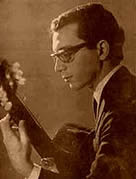
In the lecture, he told the story of how he met Segovia for the first time in 1923. It was at a house in Paris, Segovia was playing in someone's house to a small group and Tomas Teran, his friend, the pianist, brought Villa-Lobos to present to Segovia and said "have you met Villla-Lobos the composer from Brazil?" Segovia replied "yes, Miguel Llobet showed me one valse that he did. He doesn't understand the guitar very well because he asks you to make a very big stretch with the fingers of the left hand and he asks you to put the small finger to make chords with five notes."
Villa-Lobos hearing these comments took the guitar of Segovia and started to play, and Segovia was suprised with the new ideas and the flow of music. And they became friends. By chance, I heard this story from both of them. From Villa-Lobos in 1958 and from Segovia in 1965, in Santiago de Compostela. The only difference and note that is important was the way Villa-Lobos took the guitar. Segovia said that Villa-Lobos said with some vehemenece "I want this guitar." Villa-Lobos said "I want this guitar" and took it by force. But they were very close friends and, at this point, Villa-Lobos started to work on the studies. He started in 1923 and he finished in 1928.
AS - Okay, so it took him five years to write the studies.TS - Yes, and in 1962 I made the first performance of the twelve studies.
AS - I have the record.TS - Yes, I was invited by Arminda Villa-Lobos. I don't know if you have the original. On the original the cover had a picture of Villa-Lobos smoking a cigar. It was also my first record, but in 1968 I made it again, this time for Erato in France.
AS - Yes, that is the one I have. Is that first one still available or not?TS - You can find it here in the museum, but it is not for sale, but you can make copies. We have almost all of the original music here available for copy.
AS - Well, I have a few questions. There are stories about conflict between Villa-Lobos and Segovia. For instance there is a story about Villa-Lobos picking up the guitar and Segovia hating the sound that Villa-Lobos made.TS - Yes, I have heard that. But Philip Maretti, one of the two brothers who were the owners of Max Eschig, told me that many times he heard discussion, arguments, between Villa-Lobos and Segovia, mostly about the twelve studies. Segovia saying "Villa-Lobos, this is not reasonable. We can't do that," and Villa-Lobos would take the guitar and show Segovia how to do it.
AS - In fact Villa-Lobos was a good guitarist.TS - Yes, he was. There is a recording, a very old recording, of him playing the Choro Nº1. Well, there are a few little mistakes, but you see that he is very fluent, it is beautiful. There are parts of the first prelude. You notice also that he was a very good guitarist, and he was a very good interpreter of his own music, not only the guitar but as an orchestral conductor.
AS - But Segovia never recorded the studies, except for Nº1.TS - It is very important for people to understand that Segovia was the first explosion of the guitar all over the world. A wonderful guitarist. Unforgetable, like Paganani with the guitar. And very concerned with sound and quality of sound and the public. If you make a follow up of all the programmes of Segovia, in the beginning the programmes are very simple. A minuet, a Gavotte by Bach, it was normal to play small pieces like that. You can imagine somebody that built programme and thinks "well I'll put the Canzonetta by Mendelson here and Prelude by Bach, and maybe two pieces by Torroba, and then twelve studies by Villa-Lobos." That's impossible (laughs). He chose the studies that were more comfortable with this kind of programme, for instance Study Nº1, Study Nº8, and Study Nº7. He used to play these three studies. He was not too worried about playing them together as a set piece of a programme, and I am very happy about that because I could do this myself when I was eighteen years old.
AS - But Segovia did perfom them in public.TS - Yes, quite early. We have the programmes here and he played the preludes too. Prelude Three and Prelude Four.
AS - But I thought he had some problems with Prelude Three. That he didn't like it, he though it was imitation Bach.TS - No, he played it beautifully.
AS - So, the big question I have, and this was originaly told to me by Ben Verdery in New York, is about the editing of the studies. That everybody has recorded the versions as edited by Segovia but now, it has come to light that there were sections of the music that Segovia took out.TS - Let me tell you the whole story...
When I began as the director of this museum, Arminda Villa-Llobos had just died. Actually, one year before. She was his second wife. There was a big dispute between the first wife and the second wife. Villa-Lobos lived for twenty two years with Lucilia Guimarães Villa-Lobos and twenty three years with Arminda Villa-Lobos. They hated each other and there was a big conflict between the families. When Arminda died in 1985, which is when I became the director of the museum, I spent that year giving assistance to a niece of Arminda, a very good pianist Sonya Maris. One year after, the director of museums asked me to take full direction of the museum because 1986 was coming and in 1987 was the centenial of Villa-Lobos, and they wanted to have my name as the director because I was quite well known outside of Brazil.
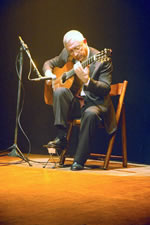
Then, I sent signals – smoke signals - to the family through the press, saying that "well, now that I am director of the museum I don’t see any reason to fight or have dispute between the families". So, what happened is that the family of Lucilia called me, and they were very kind and they started giving lots of things that had belonged to Villa-Lobos. Things that were very important to the museum. The cello I showed you and music.
One day, one of the brothers of Lucilia came here. We opened the trunk of an old volks waggon which contained a huge pile of original Villa-Lobos music. I almost died. I started looking and there were lots of the original guitar music. This was a shock! I communicated this to the publisher, Max Eschig, and I proposed that they should immediately print and publish a set of these originals. This is a treasure. I waited four years hoping they would have the initiative to do that. But nothing happened.
After four years, I decided finally to liberate the originals and gave the photocopies to everybody.
AS - When was this? During the eighties – nineties?TS - I don't want to say anything. I prefer to look to see the exact dates. But since then, many guitarists have taken the photocopies and have started to play the original version. In fact, I think that the good version is still Max Eschig. It is the one of which Villa-Lobos said "this is my version". And he didn't destroy anything, but kept everything as an archive. But in fact the best version of the studies - the one that I recorded three times in my life - is the Eschig version because this was the desire of Villa-Lobos.
AS - Yes, maybe because he was happy to let Segovia work on them. But it is so interesting because the studies display the imagination of an original mind and hold a seminal place in the literature of the guitar. Every guitarist has to confront them at some point along the way.TS - Absolutely. And you know they contain some of the ideas that became the preludes. You can find some of the ideas already in the studies.
AS - Yes. He covered a huge amount of ground with the studies and the preludes would seem to flow naturally from them.TS - The idea for Prelude number 1, for instance, is already there in study number 11.
AS - There was a break in between the studies and the preludes, wasn't there?TS - Yes. The preludes were written in 1940. Between the studies and the preludes you have a panorama of the guitar, and Villa-Lobos told me, in 1958, that he had completed his tour of the guitar – "I did everything I could do with the guitar" he said. He also said that the guitar was the instrument of his heart. He loved the cello, but the guitar was in his heart.
AS - Yes, you can hear that in the music. I have another question about the preludes. Legend has it that there was a sixth prelude.TS - Yes, and Villa-Lobos told me that it was the most beautiful one but he couldn't remember what happened to it. It was probably 1940, and the Civil War in Spain, and Segovia's originals, he couldn't remember if it was sent to Montevideo but it was lost.
AS - Is it possible that Segovia had the sixth prelude and then he moved to Montevideo and somewhere in the travel it got lost? That is very sad. You can only imagine what it might have been. A tantalising thought. Well, generally in Brazil today, how do the younger players regard Villa-Lobos? What direction is the guitar taking here?TS - The recording that I am doing at the moment, with the orchestra of the Municipal Theatre of Rio de Janeiro, has five pieces. One is the introduction to the choros by Villa-Lobos - that is the dialogue between the guitar and the orchestra. The second is the concerto for guitar and orchestra that I am recording for the third time. But the three others are new concertos.
AS - What? They are ones that you found when you received the originals?TS - No, they are concertos that were published by Max Eschig. But the introduction had hardly been recorded. When Villa-Lobos finished the whole series of Choros, he felt that it was missing something, missing an introduction. So he composed this fabulous introduction that in fact is a dialogue between the guitar and a big orchestra. The guitar comes in the middle of the piece and has a very important cadenza followed by the orchestra. The guitar plays again and comes to the choros. It is very beautiful. There are three other concertos on this record. One is by Eugenio Krieger, one of our best composers, the dean of Brazilian composers, a wonderful concerto, very Brazilian. And two others by Sergio Barbosa, a very talented composer. He's downstairs now waiting for me. We're going to the studio. He has a concerto called "Retratos do Brasil", and another that is an hommage to a famous poet here, Carlos Ramon, and is based on themes of Minas Gerais.
AS - And these concertos will all be on the same recording? You have a lot of work to do!TS - (laughs) I keep alive. But I cannot drink these days. And this is bothering me quite a lot. But I will be very happy at the end.
AS - I hear you. So all of this shows the powerful influence of Villa-Lobos, even today.TS - Yes, everywhere. It is still so strong.
AS - Yes, I feel as if I have lived through that music all of my life. Since I was a teenager. It's always had a place in my head. Could Villa-Lobos play the studies himself?TS - Yes, he could play them, but you know he didn't care to be a guitarist.
AS - No, he wasn't a concert performer.TS - No, he wasn't. But he could do all the things he wanted with the guitar. The witness was Philip Marietti of Max Esching, who saw him demonstrate the music to Segovia when they were in discussion.
At this point, Turibio had to leave us to meet with Sergio Barbosa. I thanked him and then headed to the beach of Barra da Tijuca, just south of Rio. As I got pounded back and forth by the mighty Atlantic waves, a number of thoughts came to me. Would Villa-Lobos have written this music if he had not met Segovia? Clearly the playing of Segovia was a channel and an inspiration to Villa-Lobos to write music for an instrument close to his heart. The meeting of these two men and the friction between them is what produced the music. Had there been a relationship of more obvious accord, maybe the music would have turned out differently and possibly the music would be the lesser for it.
I thought about the arrival of the original manuscripts into Turibio's hands and what a gravid situation that must have been. Turibio had met and talked with both Segovia and Villa-Lobos and was cognizant of the speculation and rumour about their relationship. But with one swift stroke – the revealing of the original manuscripts - he had severed the knot, and now the world could be the judge and the music would speak for itself.
Copies of the original manuscripts maybe obtained by writing to:
Museu Villa-Lobos
Rua Sorocaba, 200 - Botafogo
Rio de Janeiro - RJ – Brasil
ZIP: 22271-110

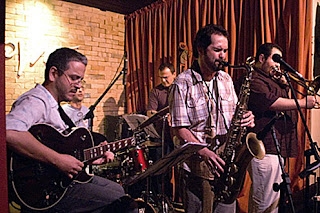 No encarte do disco, o primeiro do grupo, Marcelo dá uma pista das influências do trabalho, que partem de Ron Miller, José Eduardo Gramani, Coltrane, Dave Holland passando por Tide Hellmeister (artista plástico paulistano que ilustrava a coluna de Paulo Francis no Estadão) e Gonçalves Dias. O grupo explora a polirritimia e a polifonia em todas as composições, que são de autoria de Marcelo Coelho (responsável, também, pelos arranjos), músico com um talento surpreendente e extremamente generoso, por ser imparcial na distribuição dos espaços para improvisos por todos os instrumentistas.
No encarte do disco, o primeiro do grupo, Marcelo dá uma pista das influências do trabalho, que partem de Ron Miller, José Eduardo Gramani, Coltrane, Dave Holland passando por Tide Hellmeister (artista plástico paulistano que ilustrava a coluna de Paulo Francis no Estadão) e Gonçalves Dias. O grupo explora a polirritimia e a polifonia em todas as composições, que são de autoria de Marcelo Coelho (responsável, também, pelos arranjos), músico com um talento surpreendente e extremamente generoso, por ser imparcial na distribuição dos espaços para improvisos por todos os instrumentistas.


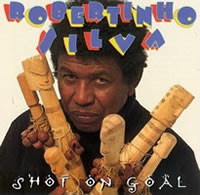
 Robertinho Silva nasceu no Rio de Janeiro no dia primeiro de junho de 1941. O percussionista e baterista Robertinho, além de tocar quase tudo, é um dos músicos mais cosmopolitas que se conhece, em se falando daqueles que vieram depois da geração Jobim/Gilberto.
Robertinho Silva nasceu no Rio de Janeiro no dia primeiro de junho de 1941. O percussionista e baterista Robertinho, além de tocar quase tudo, é um dos músicos mais cosmopolitas que se conhece, em se falando daqueles que vieram depois da geração Jobim/Gilberto. On his fourth album as a leader, Silva puts together a highly percussive (naturally) series of sessions mixing American jazz standards and jazz-rock idioms with Brazilian instruments and material. The results sometimes resemble fellow percussionist Airto Moreira's fascinating electric Brazilian jazz recordings of the '70s, though Silva's tracks are more disciplined in structure. A solo flute or saxophone, mostly in the capable hands of Mauro Senise, rises above the ensemble a la Wayne Shorter, and seven different keyboardists, including Silva himself on "Festa De Terreiro," sprinkle notes or lay down electronic textures. Aided by Silva's sons Ronaldo and Vanderlei on percussion, "Ceco Aderaldo" has a dense, rapidly fibrillating underbrush of Brazilian percussion sounds propelling the music, and Silva puts forth a thundering, hypnotic 7/4-meter display on the tom-toms in "Barra 200." In the American material, "Bemsha Swing" receives a quasi-samba treatment while also emphasizing the tune's strong roots in the blues, and "Nefertiti" rarely departs from the usual Miles Davis-oriented approach. Indeed, in the latter tune, the versatile Silva does a pretty good, meter-shifting Tony Williams impersonation.
On his fourth album as a leader, Silva puts together a highly percussive (naturally) series of sessions mixing American jazz standards and jazz-rock idioms with Brazilian instruments and material. The results sometimes resemble fellow percussionist Airto Moreira's fascinating electric Brazilian jazz recordings of the '70s, though Silva's tracks are more disciplined in structure. A solo flute or saxophone, mostly in the capable hands of Mauro Senise, rises above the ensemble a la Wayne Shorter, and seven different keyboardists, including Silva himself on "Festa De Terreiro," sprinkle notes or lay down electronic textures. Aided by Silva's sons Ronaldo and Vanderlei on percussion, "Ceco Aderaldo" has a dense, rapidly fibrillating underbrush of Brazilian percussion sounds propelling the music, and Silva puts forth a thundering, hypnotic 7/4-meter display on the tom-toms in "Barra 200." In the American material, "Bemsha Swing" receives a quasi-samba treatment while also emphasizing the tune's strong roots in the blues, and "Nefertiti" rarely departs from the usual Miles Davis-oriented approach. Indeed, in the latter tune, the versatile Silva does a pretty good, meter-shifting Tony Williams impersonation.
 Gilson Macedo é um violonista com estilo próprio, na linhagem dos grandes virtuoses, que exprime com talento e emoção seu trabalho de fusão entre o popular e o erudito.
Gilson Macedo é um violonista com estilo próprio, na linhagem dos grandes virtuoses, que exprime com talento e emoção seu trabalho de fusão entre o popular e o erudito.
 Neste pacote de registros de lançamentos excelentes - todos sérios candidatos à lista dos melhores do ano, não poderia faltar ao menos uma citação de "Trem Mineiro", terceiro elepê instrumental de Wagner Tiso, Maestro, arranjador, tecladista e sobretudo compositor, este mineiro de 36 anos, uma larga quilometragem musical, identificado com Milton Nascimento desde sua adolescência, é hoje um dos arranjadores mais diasputados. Como instrumentista compositor já revelou na série de 3 elepês do Som Imaginário toda uma extraordinária versatilidade. Mas tem sido nestes últimos três anos, em álbuns da Odeon, onde tem tido liberdade para colocar todas suas idéias e concepções, que tem atingido os pontos mais altos. Ao contrário dos dois discos instrumentais anteriores, "Trem Mineiro", por razões econômicas, não teve a ampla secção de cordas que Tiso tão bem sabe utilizar. Em compensação, a integração com músicos como Mauro Senise (sax alto), Cidinho (percussão), Luisão (baixo), Roberto Silva (bateria), Ricardo Silveira (guitarra - violão - ovation), Serginho (trombone), Leo Gandelman (sax alto), faz com que cada uma das oito faixas se ouça com uma imensa emoção. Classificar em gêneros e graus, procurar descrição de palavras para transmitir a beleza, a harmonia e as cores sonoras com que Wagner marca este seu trabalho, é, em nosso entender, quase impossível. Com exceção de "Banda da Capital", parceria com Nivaldo Ornellas e uma regravação de "Os Pássaros" (Milton Nascimento) as outras composições são exclusivamente de Wagner. E em todas sente-se como um trabalho perfeito quando lhe dão condições: "Cello Caribe", "Sobe Serra, Desce Serra", "Mata Burro", "Trem Torto" e "Trem Mineiro", são temas instrumentais que sem deixarem de serem brasileiríssimos, podem emocionar pessoas de qualquer parte do mundo. Sem falar em "Armina", composição dos tempos do Som Imaginário, que volta em nova roupagem. Um disco emocionante e antológico, o mínimo a dizer...
Neste pacote de registros de lançamentos excelentes - todos sérios candidatos à lista dos melhores do ano, não poderia faltar ao menos uma citação de "Trem Mineiro", terceiro elepê instrumental de Wagner Tiso, Maestro, arranjador, tecladista e sobretudo compositor, este mineiro de 36 anos, uma larga quilometragem musical, identificado com Milton Nascimento desde sua adolescência, é hoje um dos arranjadores mais diasputados. Como instrumentista compositor já revelou na série de 3 elepês do Som Imaginário toda uma extraordinária versatilidade. Mas tem sido nestes últimos três anos, em álbuns da Odeon, onde tem tido liberdade para colocar todas suas idéias e concepções, que tem atingido os pontos mais altos. Ao contrário dos dois discos instrumentais anteriores, "Trem Mineiro", por razões econômicas, não teve a ampla secção de cordas que Tiso tão bem sabe utilizar. Em compensação, a integração com músicos como Mauro Senise (sax alto), Cidinho (percussão), Luisão (baixo), Roberto Silva (bateria), Ricardo Silveira (guitarra - violão - ovation), Serginho (trombone), Leo Gandelman (sax alto), faz com que cada uma das oito faixas se ouça com uma imensa emoção. Classificar em gêneros e graus, procurar descrição de palavras para transmitir a beleza, a harmonia e as cores sonoras com que Wagner marca este seu trabalho, é, em nosso entender, quase impossível. Com exceção de "Banda da Capital", parceria com Nivaldo Ornellas e uma regravação de "Os Pássaros" (Milton Nascimento) as outras composições são exclusivamente de Wagner. E em todas sente-se como um trabalho perfeito quando lhe dão condições: "Cello Caribe", "Sobe Serra, Desce Serra", "Mata Burro", "Trem Torto" e "Trem Mineiro", são temas instrumentais que sem deixarem de serem brasileiríssimos, podem emocionar pessoas de qualquer parte do mundo. Sem falar em "Armina", composição dos tempos do Som Imaginário, que volta em nova roupagem. Um disco emocionante e antológico, o mínimo a dizer... Wagner Tiso is a model of contemporary musician. Composer, conductor, arranger, his creations are imbued with a vigorous Brazilian sound expression. The fusion of several musical elements, which shape his compositions – from the gipsy sentimentalism to the baroque style of Minas Gerais – gives this magnificent musician a sense of exceptional musicality.
Wagner Tiso is a model of contemporary musician. Composer, conductor, arranger, his creations are imbued with a vigorous Brazilian sound expression. The fusion of several musical elements, which shape his compositions – from the gipsy sentimentalism to the baroque style of Minas Gerais – gives this magnificent musician a sense of exceptional musicality.
 Em 7 de março último, o violonista Turíbio Santos completou 60 anos de idade. Seu trabalho é conhecido internacionalmente desde 1965, quando então venceu o famoso Concurso da ORTF, na França. Vários autores dedicaram-lhe peças, tais como Radamés Gnattali, Edino Krieger, Almeida Prado, Ricardo Tacuchián, Francisco Mignone e Leo Brouwer.
Em 7 de março último, o violonista Turíbio Santos completou 60 anos de idade. Seu trabalho é conhecido internacionalmente desde 1965, quando então venceu o famoso Concurso da ORTF, na França. Vários autores dedicaram-lhe peças, tais como Radamés Gnattali, Edino Krieger, Almeida Prado, Ricardo Tacuchián, Francisco Mignone e Leo Brouwer. On a bleak winters night in January 2003 I sat in my bedroom in the hotel Manhattan with the Brazillian guitarist Victor Biglione and my friend the classical guitarist Ben Verdery. In the middle of a happy situation where we worked our way through a bottle of Dom Perignon and a couple of songs that we would play the subsequent night at Joe's Pub, Ben started to play some of the Villa-Lobos studies. Half way through study number eight Ben looked up and said "of course you know about the edits" and then proceeded to tell me about the original Villa-Lobos manuscripts and that it now appears that Segovia had edited some of the original writing. I poured another glass of Dom, while Ben played a beautiful chordal sequence from the 1928 version of study number ten, but missing in the 1929.
On a bleak winters night in January 2003 I sat in my bedroom in the hotel Manhattan with the Brazillian guitarist Victor Biglione and my friend the classical guitarist Ben Verdery. In the middle of a happy situation where we worked our way through a bottle of Dom Perignon and a couple of songs that we would play the subsequent night at Joe's Pub, Ben started to play some of the Villa-Lobos studies. Half way through study number eight Ben looked up and said "of course you know about the edits" and then proceeded to tell me about the original Villa-Lobos manuscripts and that it now appears that Segovia had edited some of the original writing. I poured another glass of Dom, while Ben played a beautiful chordal sequence from the 1928 version of study number ten, but missing in the 1929. TS - It was given to Villa-Lobos in 1923, in Paris, by Tomas Teran. He was a pianist that afterwards came to Brazil and stayed here for the rest of his life.
TS - It was given to Villa-Lobos in 1923, in Paris, by Tomas Teran. He was a pianist that afterwards came to Brazil and stayed here for the rest of his life. In the lecture, he told the story of how he met Segovia for the first time in 1923. It was at a house in Paris, Segovia was playing in someone's house to a small group and Tomas Teran, his friend, the pianist, brought Villa-Lobos to present to Segovia and said "have you met Villla-Lobos the composer from Brazil?" Segovia replied "yes, Miguel Llobet showed me one valse that he did. He doesn't understand the guitar very well because he asks you to make a very big stretch with the fingers of the left hand and he asks you to put the small finger to make chords with five notes."
In the lecture, he told the story of how he met Segovia for the first time in 1923. It was at a house in Paris, Segovia was playing in someone's house to a small group and Tomas Teran, his friend, the pianist, brought Villa-Lobos to present to Segovia and said "have you met Villla-Lobos the composer from Brazil?" Segovia replied "yes, Miguel Llobet showed me one valse that he did. He doesn't understand the guitar very well because he asks you to make a very big stretch with the fingers of the left hand and he asks you to put the small finger to make chords with five notes." Then, I sent signals – smoke signals - to the family through the press, saying that "well, now that I am director of the museum I don’t see any reason to fight or have dispute between the families". So, what happened is that the family of Lucilia called me, and they were very kind and they started giving lots of things that had belonged to Villa-Lobos. Things that were very important to the museum. The cello I showed you and music.
Then, I sent signals – smoke signals - to the family through the press, saying that "well, now that I am director of the museum I don’t see any reason to fight or have dispute between the families". So, what happened is that the family of Lucilia called me, and they were very kind and they started giving lots of things that had belonged to Villa-Lobos. Things that were very important to the museum. The cello I showed you and music.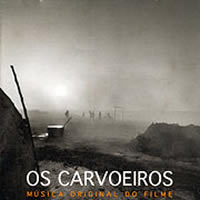
 Em 1990, formou-se em música para cinema e televisão na Berklee College of Music de Boston (Massachussets, EUA).
Em 1990, formou-se em música para cinema e televisão na Berklee College of Music de Boston (Massachussets, EUA).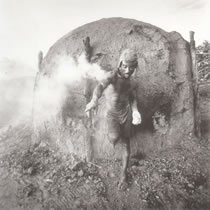 Nigel Noble's documentary about the lives of the carvoeiros, the migrant workers who produce charcoal from the trees of the Brazilian rain forests, is based on an award-winning photographic essay, and that is how it is best appreciated.
Nigel Noble's documentary about the lives of the carvoeiros, the migrant workers who produce charcoal from the trees of the Brazilian rain forests, is based on an award-winning photographic essay, and that is how it is best appreciated. 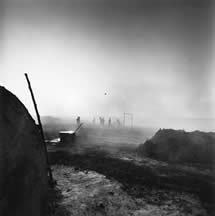 The trees harvested from the forests are used in the production of charcoal for the steel industries around the world to manufacture cars, buildings, etc. While the ecological consequences of this are touched upon in the film, it is generally far more interested in depicting the exact nature of the process and exploring the lives of the workers who must endure highly difficult conditions for very modest wages. The people on display here range from a 76-year-old man who exhibits an impressive physical vigor -- his parents, he informs us, lived well into their hundreds -- to a 9-year-old child who, it's quite clear, has few options for his future.
The trees harvested from the forests are used in the production of charcoal for the steel industries around the world to manufacture cars, buildings, etc. While the ecological consequences of this are touched upon in the film, it is generally far more interested in depicting the exact nature of the process and exploring the lives of the workers who must endure highly difficult conditions for very modest wages. The people on display here range from a 76-year-old man who exhibits an impressive physical vigor -- his parents, he informs us, lived well into their hundreds -- to a 9-year-old child who, it's quite clear, has few options for his future. 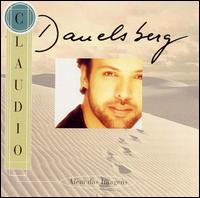
 Claudio vem se tornando um dos instrumentistas em maior evidência no cenário da Música Instrumental Brasileira. Dono de um temperamento inquieto, sempre buscando inovações, Claudio é constantemente requisitado como pianista, arranjador e compositor, atuando ao lado de grandes nomes do cenário musical como: Plácido Domingo, Bob Mintzer, Bireli Lagrane, Tooth Tileman, Chick Corea, Sandra de Sá, Cláudio Nucci, Zélia Duncan, Nivaldo Ornellas, Robertinho Silva, Nico Assumpção, Arthur Maia, Torcuato Mariano, Carlos Bala, Mauro Senise, Carlos Malta, Marcos Suzano, Jacques Morelenbaum, Toninho Horta, Paulo Braga e outros grandes nomes da MPB.
Claudio vem se tornando um dos instrumentistas em maior evidência no cenário da Música Instrumental Brasileira. Dono de um temperamento inquieto, sempre buscando inovações, Claudio é constantemente requisitado como pianista, arranjador e compositor, atuando ao lado de grandes nomes do cenário musical como: Plácido Domingo, Bob Mintzer, Bireli Lagrane, Tooth Tileman, Chick Corea, Sandra de Sá, Cláudio Nucci, Zélia Duncan, Nivaldo Ornellas, Robertinho Silva, Nico Assumpção, Arthur Maia, Torcuato Mariano, Carlos Bala, Mauro Senise, Carlos Malta, Marcos Suzano, Jacques Morelenbaum, Toninho Horta, Paulo Braga e outros grandes nomes da MPB.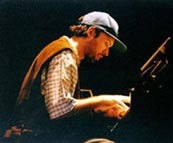 A renowned pianist, arranger, and/or composer in Brazil, Cláudio Dauelsberg has worked with such acts as Plácido Domingo, Bob Mintzer, Chick Corea, Sandra de Sá, Zélia Duncan, Márcio Montarroyos, Nivaldo Ornellas, Hermeto Paschoal, and Robertinho Silva. As a solo pianist, he has performed in several cities in Brazil with the Geneva Chamber Orchestra, conducted by Tierry Fischer, and with the Orquestra Nacional de Brasília, conducted by Helena Herrera. Since 1987, he has developed several years of work with Délia Fischer in the Duo Fênix, who recorded three albums and performed in several international jazz festivals, such as Montreux and Sophia, along with the Free Jazz Festival in Brazil in 1990. He recorded his first solo CD in 1998, Além das Imagens, and in the next year, toured Europe, participating in the Montreux Festival (Switzerland). Having studied classical piano since his childhood, at 14 he had already participated in important national festivals like Rio's Lorenzo Fernandes and Porto Alegre's Concurso Nacional Natho Henn. Dauelsberg studied at the Berklee School of Music, returning to Brazil in 1987.
A renowned pianist, arranger, and/or composer in Brazil, Cláudio Dauelsberg has worked with such acts as Plácido Domingo, Bob Mintzer, Chick Corea, Sandra de Sá, Zélia Duncan, Márcio Montarroyos, Nivaldo Ornellas, Hermeto Paschoal, and Robertinho Silva. As a solo pianist, he has performed in several cities in Brazil with the Geneva Chamber Orchestra, conducted by Tierry Fischer, and with the Orquestra Nacional de Brasília, conducted by Helena Herrera. Since 1987, he has developed several years of work with Délia Fischer in the Duo Fênix, who recorded three albums and performed in several international jazz festivals, such as Montreux and Sophia, along with the Free Jazz Festival in Brazil in 1990. He recorded his first solo CD in 1998, Além das Imagens, and in the next year, toured Europe, participating in the Montreux Festival (Switzerland). Having studied classical piano since his childhood, at 14 he had already participated in important national festivals like Rio's Lorenzo Fernandes and Porto Alegre's Concurso Nacional Natho Henn. Dauelsberg studied at the Berklee School of Music, returning to Brazil in 1987.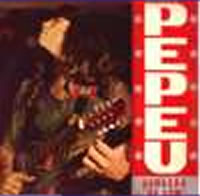
 Na adolescência aprendeu violão, guitarra e bandolim. Foi guitarrista do grupo Novos Baianos na década de 70 e partiu para a carreira individual com o final do grupo, por volta de 1978. É desse ano o primeiro LP solo, "Geração de Som", totalmente instrumental. Na companhia da mulher, a cantora Baby Consuelo (depois Baby do Brasil), virou um ícone de roqueiro nos anos 80, época em que passou a cantar também. Nessa fase, o maior sucesso foi "Masculino e Feminino", disco gravado nos Estados Unidos cuja faixa-título foi muito executada pelas rádios. No final da década de 80 voltou-se para a música instrumental, participando de festivais de jazz e lançando, em 1989, "Instrumental On The Road". Nos anos 90 dedicou-se mais a seu trabalho como guitarrista, relendo velhos sucessos como os chorinhos "Brasileirinho" (Waldir Azevedo) e "Noites Cariocas" (Jacob do Bandolim), presentes no início de sua carreira e que fizeram sua fama de virtuose. Também enveredou por um estilo mais pop, com o lançamento de "Meu Coração" em 1999.
Na adolescência aprendeu violão, guitarra e bandolim. Foi guitarrista do grupo Novos Baianos na década de 70 e partiu para a carreira individual com o final do grupo, por volta de 1978. É desse ano o primeiro LP solo, "Geração de Som", totalmente instrumental. Na companhia da mulher, a cantora Baby Consuelo (depois Baby do Brasil), virou um ícone de roqueiro nos anos 80, época em que passou a cantar também. Nessa fase, o maior sucesso foi "Masculino e Feminino", disco gravado nos Estados Unidos cuja faixa-título foi muito executada pelas rádios. No final da década de 80 voltou-se para a música instrumental, participando de festivais de jazz e lançando, em 1989, "Instrumental On The Road". Nos anos 90 dedicou-se mais a seu trabalho como guitarrista, relendo velhos sucessos como os chorinhos "Brasileirinho" (Waldir Azevedo) e "Noites Cariocas" (Jacob do Bandolim), presentes no início de sua carreira e que fizeram sua fama de virtuose. Também enveredou por um estilo mais pop, com o lançamento de "Meu Coração" em 1999.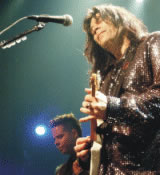 Pepeu Gomes is a virtuoso guitarist/mandolinist who had noted participation in the '70s revival of choro in the band Os Novos Baianos. His solo career has been troubled by the hardships that prevent instrumental musicians in Brazil from developing their discoveries, but his recorded material is enough to make clear his uncanny, creative talent.
Pepeu Gomes is a virtuoso guitarist/mandolinist who had noted participation in the '70s revival of choro in the band Os Novos Baianos. His solo career has been troubled by the hardships that prevent instrumental musicians in Brazil from developing their discoveries, but his recorded material is enough to make clear his uncanny, creative talent. 
 Br-Instrumental no Twitter
Br-Instrumental no Twitter




